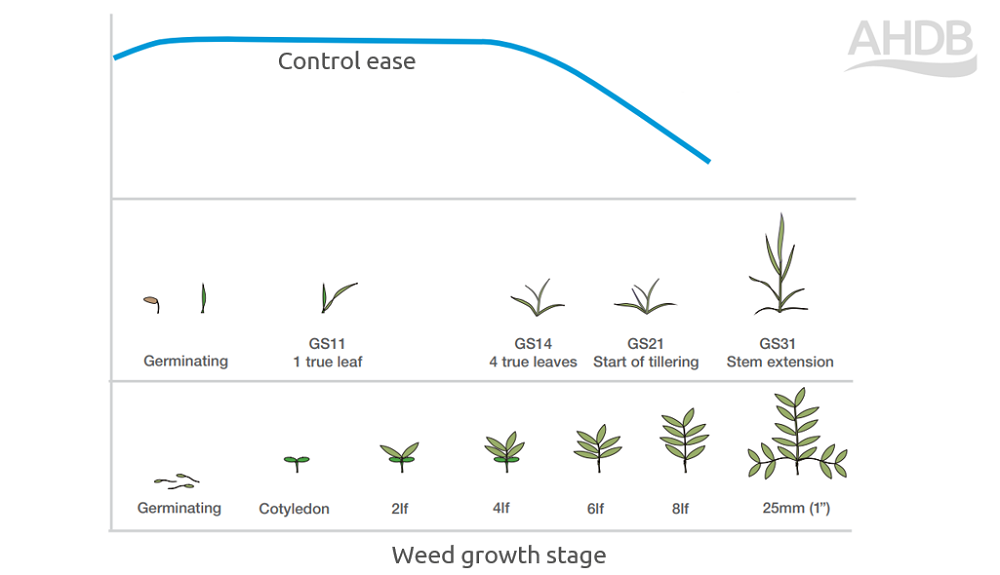- Home
- Knowledge library
- Spray timing and herbicide efficacy in cereals and oilseed rape
Spray timing and herbicide efficacy in cereals and oilseed rape
Effective grass-weed control is essential in rotations with autumn-sown crops. Although product labels and technical support provide guidance on how to optimise herbicide effectiveness in specific situations, these general principles apply to all crops.
Herbicide timing in autumn-sown cereal crops
Herbicides form a large part, typically 20–30%, of the variable costs associated with producing a crop. With the need to consider herbicide-resistance risks too, it is important to target each spray required. This table (below) outlines the pros and cons associated with the key herbicide spray timings in autumn-sown cereal crops.
|
Herbicide timing in autumn-sown crops |
Aim |
Mode of action |
Advantages |
Disadvantages |
|
Pre-drilling |
Encourage weed growth. Control weeds from harvest to drilling |
Contact |
Can use non-selective herbicides, which reduce resistance risk |
Early drilling shortens time for weeds to emerge and be controlled |
|
At drilling |
Apply before crop or weeds emerge, within 24–48 hours of drilling. Control weeds until end of winter |
Residual |
Prevents weed establishment. Essential building block of grass weed control; only effective timing for some species/herbicides. Limited resistance to pre-em herbicides |
Poor weed control where seedbed quality is poor or seedbeds are dry. Crop seed depth, or soil cover, can be an issue with some herbicides |
|
Autumn/winter |
Control later-germinating weeds or escapees from pre-emergence treatments. Target weeds when small |
Residual Contact |
Weeds visible to identify, which aids product choice |
Control more difficult if weeds are large. Soils can be too wet. Stressed crops. Large crop canopies. Resistance problems common. Beware cold temperatures, which can reduce efficacy of some herbicides |
|
Spring |
Control spring-germinating weeds. Tidy up winter escapees |
Contact Some residual |
Weed spectrum visible |
Large weed size. Sometimes too late for certain species. Target crop growth stage is missed |
|
Pre-harvest |
Control late-germinating and perennial weeds |
Contact |
Ideal timing for perennial weeds |
Few species at correct growth stage. Some weed seed set. Some crop market restrictions |
Spray timing and herbicide resistance
Key annual grass-weed species at risk from herbicide resistance include black-grass and Italian rye-grass. When applying glyphosate prior to drilling a crop, maximise efficacy (to reduce the number of survivors), always aim to:
- Use the manufacturer’s recommended dose rate for the weed sizes present*
- Apply prior to ‘shading’ from other plants
- Apply to actively growing plants in warm conditions (15–25°C), with at least 6 hours before any rainfall
*Small weeds are particularly challenging targets, especially grass weeds because of their vertical structure. Ideally, spray when plants are at least 5 cm but before the start of rapid stem extension.
 AHDB
AHDB
Reduced glyphosate doses increase the risk of lower efficacy
Typically, annual grasses require a minimum of:
- 540g a.i./ha for seedlings up to 2-3 leaves
- 720g a.i./ha when tillering
- 1,080g a.i./ha when flowering
How to minimise glyphosate resistance risks in grass weeds (full guidance)
Weed Resistance Action group (general herbicide resistance guidance)
Herbicide programmes
Autumn-sown cereals
Mixtures (several products applied together) or sequencing/stacking (several products applied in close succession) are more effective at controlling grass weed populations than individual products. Pre-emergence options are less affected by resistance and should form a key part of a cereal herbicide programme.
Oilseed rape herbicides
Spring herbicide options are limited in oilseed rape and weed control decisions need to be made prior to drilling. Establishment methods and weeds present affect control options:
- Where shepherd’s-purse and/or cleavers are predicted, a robust pre-emergence treatment – based on metazachlor – is required. Rapeseed must be well covered by soil to a depth of 15mm
- For black-grass and other grass weeds, herbicides such as propyzamide are more effective after no or very shallow cultivation. Where deeper cultivations are used, adding a graminicide (‘fop’ or ‘dim’) will improve the level of control.
Spray application and herbicide efficacy in cereals and oilseed rape
Find out how to optimise herbicide application techniques to make every drop count in the fight against arable weeds. This page covers spray equipment (e.g. nozzles) and rates.
Spray application and herbicide efficacy in cereals and oilseed rape
 AHDB.JPG) AHDB
AHDB
Topics:
Sectors:
Tags:

